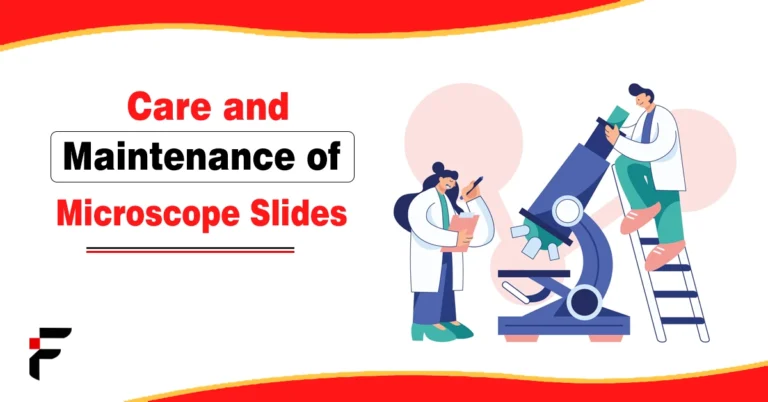Throughout high school and into my early college years, the microscope felt like a portal to unseen worlds. But as any serious student of biology would attest, the effectiveness of a microscope depends partly on the quality of the slides used. After countless experiences in my school’s lab, I learned the importance of proper care and maintenance of microscope slides, vital for clarity and accuracy during examination.
In this blog post, I will explain how I ensure the longevity and efficacy of Microscope slides.
Guide for Care and Maintenance of Microscope Slides
Start with Proper Cleaning
There’s nothing more frustrating than finding a significant smudge or stray streak of dust obscuring your view just as you’re about to spot an elusive pollen grain. The solution? Start clean. I always keep a dedicated set of cleaning materials on hand: soft lens paper, distilled water, and a touch of alcohol for stubborn stains. Remember, cleanliness starts at the beginning. Always clean slides before use, even if they seem spotless upon initial inspection.
The next recommendation is to clean your slides right after you have used them. Cleaning samples is easier to do when the remains are still wet, although dry stains are more difficult to eliminate (and may become permanent stains). I bought a soft-bristle brush that can clean debris without scratching the glass. The technique has made me save myself numerous graining moments, and I have been able to concentrate more on the microscopic analysis admitting no distractions in the form of cleaning.

Proper Storage Methods
Early on, I made the mistake of stacking slides haphazardly in a box. The result? Scratches galore. I soon learned that proper storage is paramount. After use, slides should be cleaned and placed in a slide holder or storage box without touching each other. Storing them upright, as opposed to flat, helps prevent unexpected chips and scratches.
When considering storage options, microscope slide storage solutions made from high-quality materials offer an added layer of protection for your invaluable slides. Selecting the right storage can help to maintain organization and ensure that your slides remain in excellent condition over time.
It’s worthwhile to regularly inspect your storage areas for dust or moisture that might accumulate over time. A periodic wipe-down and moisture-absorbing packets can safeguard your slides from unexpected wear. I’ve also learned to take note of temperature and humidity levels in the storage space — extreme conditions can sometimes alter the state of certain samples, especially in long-term storage scenarios.
Handling with Care
Reflecting on my early microscope days, I often left greasy fingerprints on slides until a teacher’s discerning eye pointed them out. And although anyone might think handling them is intuitive, the truth is that careful handling is a learned skill. Hold slides by their edges, avoiding the slide’s flat surfaces. This prevents any oils or debris from transferring to the glass. Remember, the clearer the slide, the better the microscopic analysis.
It’s also beneficial to wear gloves when handling slides, especially during experiments involving chemicals or biological samples. The gloves act as a barrier, keeping the slides safe from oils, even the natural ones from our hands. By doing so, not only do you protect the glass, but you also prevent possible contamination of the samples, which is especially important in more intricate studies.
Labeling Isn’t Just for Organization
I recall organizing a series of slides for a detailed biology project. The meticulous tracing of nerve endings fascinated me, but what truly impressed my instructor was my effective labeling system. Not only does proper labeling keep things orderly, but it also prevents mistakes during identification. Use a fine-tip permanent marker on the frosted end of the slide and include information like specimen type and date. This practice will pay off in time efficiency and accuracy.
To enhance the labeling process, consider color-coding your slides as part of your organization method. Different colors can indicate various sample origins or functions, like distinguishing between plant and animal specimens. This visual cue system has helped me retrieve the right slide faster and serves as an additional organizational tool that complements traditional labeling methods.
Change Coverslips with Care
Those tiny squares of glass, or coverslips, are so thin – I once shattered several just trying to apply them too quickly. They protect your specimen from dust and contaminants, but can crumple under pressure. To change them, gently place a new coverslip over your slide, applying only slight pressure to seal it to the liquid. Changing coverslips regularly limits the risk of contamination.
In experiments where samples require prolonged study, using coverslips of slightly thicker glass can enhance durability without compromising the view. It’s a small adjustment that has proven useful for repeated viewing sessions. Moreover, when replacing coverslips, ensuring clean tools will contribute to clearer, unobstructed viewings, encouraging a seamless transition between observations.
The Importance of Documentation
As a young biology enthusiast, I’d sometimes get overly excited about what I saw under the lens, sketching without capturing full details. Over time, recording what you observe becomes as important as the experiment itself. Writing notes on the slide label, logging data in a journal, and photographing specimens for a digital record all provide a comprehensive way to document findings. I’ve found this practice indispensable for referring back to previous research when needed.
Consider creating a digital database for your slide-related observations. By compiling scanned images, notes, and test results, you create an accessible archive to share with peers or reference during future investigations. This electronic documentation format has aided my understanding and retains continuity in my work, allowing standalone observations to connect with larger, more comprehensive studies.
Conclusion
Microscope slides play an imperative role in the study of biology as the microscope itself. Whenever I install a new slide, I remember the need to behave well and with dignity during use and when storing. Properly applied, such pieces of glass become important aids in the study of the microscopic universe. Like all things in life, with due practice and care, it will soon become second nature to keep your microscope slides in tip-top condition, and each time you use this tool, you will be able to view a new world through that lens joyfully.


